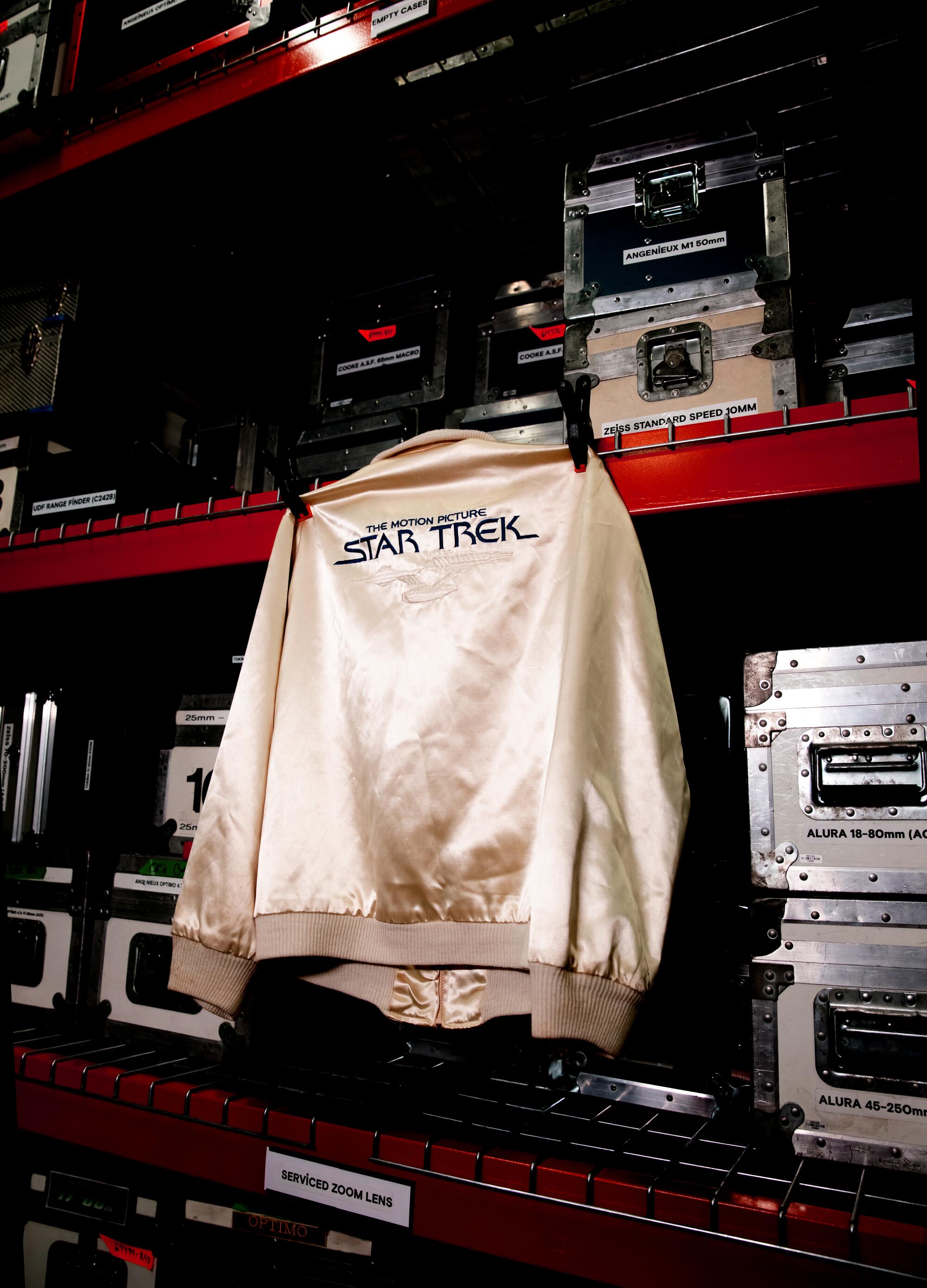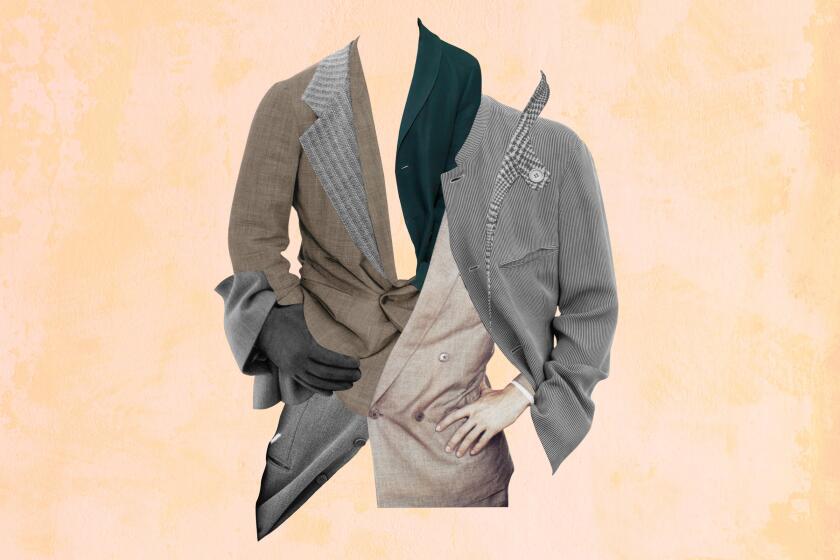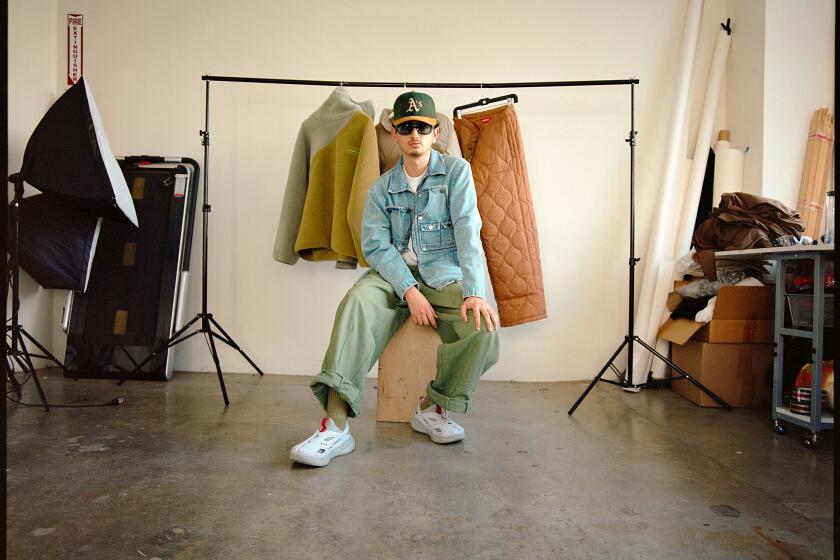
This story is part of Image issue 13, “Image Makers,” a celebration of the L.A. luminaries redefining the narrative possibilities of fashion. Read the whole issue here.
Los Angeles is the ancestral home of the movie business, but it’s also a graveyard. L.A. is where old films go to die. In the case of Warner Bros.’ “Batgirl,” that might be all too literal — the movie was nearly finished when the studio scrapped it to earn a tax write-off. But when it comes to the biz, I’m talking about a more metaphorical death: the death of cultural relevance. When movies lose their appeal with the public, turn into cult objects or just fall out of print on home video, what is left of the work? A ghost of a memory in the mind of an obsessive. Increasingly, the people desperate to remember the movies that played on repeat on pay-cable in the 20th century are turning to the detritus of show business: crew jackets given out at wrap parties.
Crew jackets and movie set memorabilia are littered all over thrift and antique stores around the L.A. area. They’re little shreds of tangible nostalgia and conversation starters in social settings. A gaudy film logo slapped on the front or back of a bomber jacket. But as physical media becomes more and more scarce and companies like Warner Bros. Discovery bury films deep in their vaults, these pieces of memorabilia might be all we have left of the movies that defined us and inspired us to move to L.A. (or kept us here, for the natives) in the first place. A crew jacket, often soft satin and sporting lunch stains and cigarette burns from the Teamster who used to own it, can be a conversation starter, a collector’s item or a status symbol. For me, it’s all three.
Who says you don’t need outerwear in your closet in L.A.? How to find the perfect jacket in a city of microclimates and many moods.
I first came into possession of an authentic crew jacket back in 2010. A friend found a jacket from the 1979 film “Star Trek: The Motion Picture” at a thrift store in Pasadena. The movie is slow, overly intellectual and filled with bizarre disco-era costume choices, like Dr. “Bones” McCoy in a tight jumpsuit that exposed most (if not all) of his chest hair. Unlike most human beings, this is my favorite “Star Trek” film.
The jacket was in pretty rough shape. Some of the stains on the arm resembled blood smears. I tried my best to disabuse myself of the notion that the previous owner of the jacket was a key-grip-turned-serial-killer. “It’s a lovely shade of paint, I’m sure,” I’d tell myself. There were other random stains on the jacket too. It had been decades since this jacket was new, so some wear and tear was to be expected. But this was the 2010s. One could get away with looking mildly disheveled. Today, I hardly wear the thing. The stains will never come out. The elastic cuffs are uncomfortable. I’ve gained enough pandemic weight that my chances of fitting into it comfortably are far slimmer than I am at present.
Still, the owning of the thing is as important as the utility of the object.
The crew jacket is one of many gifts given out to cast and crew to commemorate the completion of a film or TV show. It is not a fashion item for the initial owner. It might not even be worn that often in public. After all, how many times do you need to remind people you worked in craft services on “The Shrink Next Door,” a television show that came out last year? I was given a Patagonia sweater for the third season of the AMC series “Halt and Catch Fire” and it takes up a place in my closet, but I will probably never wear it again, unless it’s a laundry day. Or if every single one of my other jackets has been stolen.
These jackets — and the hats, T-shirts and other ephemera that keep the Hollywood gifting industry going — are about preserving a memory. When that memory ceases to matter to the owner, they go off to the thrift store, eBay, Grailed or any other second-hand clothing emporium to wait until a discerning customer decides they want to rep the Clint Eastwood/Burt Reynolds vehicle “City Heat.” No, I don’t remember this movie either. I assure you that it’s real.
The early 2000s saw celebutantes like Lindsay Lohan and Paris Hilton rocking their Uggs to Starbucks runs and lunches. Now, the ‘can’t be bothered’ boot is back.
“City Heat” was released on Dec. 7, 1984. It was written by film comedy legend Blake Edwards and directed by the actor Richard Benjamin, perhaps best known for playing the lead in the original “Westworld.” The film has a paltry 22% rating on Rotten Tomatoes and is infamous for a story in which Burt Reynolds was hit in the face with a steel chair and had to be restricted to a liquid diet as his jaw healed, causing him to lose 30 pounds. For $3, you can watch this movie on Apple TV+, Amazon Prime or YouTube. The last time the film was released on physical media was 2010. If I were a betting man, I’d wager a full paycheck that “City Heat” will never be released on a disc of any kind ever again in the history of human civilization. A sobering realization.
It’s not for everyone. It’s for those who get it. Just like Armani.
“City Heat” still exists as a beautiful bomber jacket. The back of the jacket is adorned with the stylized cartoon faces of Eastwood and Reynolds, before Burt had to have his jaw wired shut. Embroidered on the front is the inscription “With Love & Luck, Burt Reynolds.” As movies like “City Heat” fall deeper into obscurity, these crew jackets become more of a lifeline to the history of Los Angeles and bizarre stories like Burt Reynolds getting a WWE-style chair shot to the head on a movie set. While the movies go out of style and are harder to find in the galaxy of streaming media, the jackets never do.
In the not-too-distant future, these jackets might be all we have left of an entire generation of filmed entertainment. They represent the toil, creative energy and care that went into the making of a motion picture, even if that movie ended up being terrible. Los Angeles is not considered a blue-collar town, but the city is full of men and women who carry heavy things for a living and are just as important to the film industry as any star, writer or director. When movies disappear from streaming or are, like “Batgirl,” buried to turn a minor profit, these jackets might be the last thing that represents months of work and millions of dollars in effort. Plus, they look pretty great too.
More stories from Image
The L.A.-based designer behind TOMBOGO uses sustainable materials to create clothes that feel fluid, scrappy and utilitarian.
Physical spaces in L.A. have always been sacred. Ashley S.P. and Jennifer Zapata see their concept shop as a vehicle for community and an homage to their friendship.
The skater and model didn’t need the industry to show her what was cool. She figured it out by getting right within.














